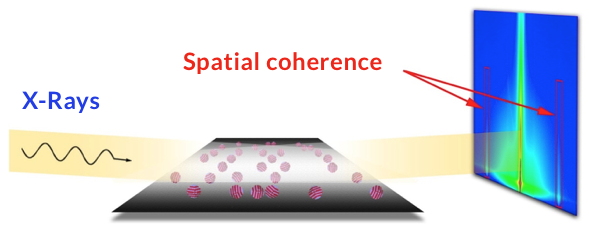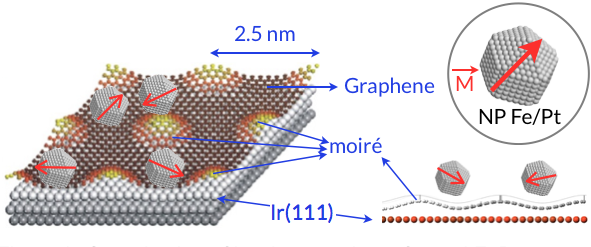The realization of two-dimensional crystals of magnetic nanoparticles with a period of a few nanometers is a kind of Grail that could pave the way for the storage of even more information on smaller areas. Over the years, researchers at IRIG and at ESRF in Grenoble (BM32 line) have developed all the components and characterization techniques needed to progress in this direction.
The growth of a graphene monolayer on iridium single crystals allowed them to synthesize a two-dimensional lattice of
2.5 nm period. The development of small-angle scattering and X-ray diffraction techniques (
Figure 1) sensitive to nanometric material quantities has allowed these researchers to characterize the organization, size, shape and atomic structure of these lattices and nanoparticles.
 Figure 1. Synchrotron X-ray scattering at small angles in grazing incidence (GISAXS) that provides, on a two-dimensional detector, the Fourier transform (along a specific direction) of an assembly of nanoparticles (NP) on a substrate.
Figure 1. Synchrotron X-ray scattering at small angles in grazing incidence (GISAXS) that provides, on a two-dimensional detector, the Fourier transform (along a specific direction) of an assembly of nanoparticles (NP) on a substrate.
Researchers at IRIG have
collaborated with researchers at the Institut Lumière Matière in Lyon who are capable to produce iron-platinum nanoparticles which, by annealing, chemically organize themselves on an atomic scale and acquire magnetization. Then, they showed that not only do these particles organize themselves on the
moiré lattice of graphene on iridium (
Figure 2), but that they keep their magnetization (linked to their chemical order) and their supra-organization up to high temperatures, taking a further step towards a possible ultra-high magnetic storage density.
 Figure 2. Organization of hard magnetic preformed FePt nanoparticles on the 2D lattice of graphene on Ir(111). There is a coincidence network of atomic sites every 10 Ir meshes and every 11 graphene meshes, generating a 2D network of periodic adsorption sites. Circle = magnetic nanoparticle.
Figure 2. Organization of hard magnetic preformed FePt nanoparticles on the 2D lattice of graphene on Ir(111). There is a coincidence network of atomic sites every 10 Ir meshes and every 11 graphene meshes, generating a 2D network of periodic adsorption sites. Circle = magnetic nanoparticle.
2.5 nm period obtained thanks to the moiré (or interference) effect between the two lattices of different parameters.
This
team is specialized in the development and "soft" deposition of preformed nanoparticles of very-well defined sizes (1 or 2 nm) and in their "soft" (or slow) deposition on surfaces.
Moiré: superposition of two crystalline networks with different periods.